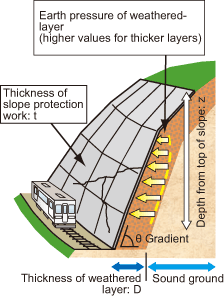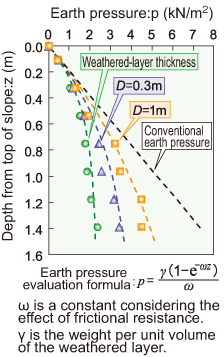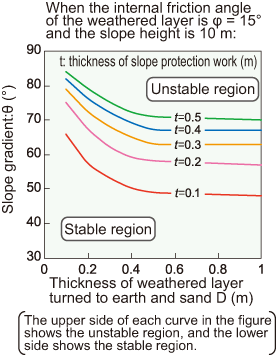10. Method to evaluate the soundness of slope protection work on cut earth sections
- RTRI gained clarification on weathered layer earth pressure characteristics exerted on slope protections of cut earth works and proposed an earth pressure evaluation formula taking the effects of weathered-layer thickness into consideration.
- It also prepared a stability evaluation nomogram for slope protection work taking weathered-layer thickness on cut earth works into consideration.
If the ground at the back of slope protection work in cut earth sections is reduced to earth and sand as a result of weathering, there is a risk that pressure will gradually build up on the slope protection work area through the weathered layer, causing that area to become unstable over time (Fig. 1). Accordingly, the RTRI clarified the earth pressure characteristics of weathered layers by performing an earth pressure measurement experiment modelling the ground to simulate the weathered layer at the back of slope protection work. At the same time, a method to evaluate the stability of slope protection work in cut earth sections was also investigated. The outcome was developed into a technique to evaluate the soundness of slope protection work in cut earth sections, taking ground weathering into consideration.
The results of the earth pressure measurement experiment clarified the fact that the earth pressure exerted by a weathered layer that has turned to earth and sand is smaller than that obtained using the ordinary earth pressure estimation formula due to frictional resistance exerted by the slope protection work and sound ground (Fig. 2). Based on these results, an earth pressure evaluation formula was found which accurately took into account the effects of weathered-layer thickness. Stability analysis was also performed by applying this earth pressure evaluation formula to various conditions, and a stability evaluation nomogram was produced for slope protection work in cut earth sections by setting the height of the slope, the strength of weathered layers, the gradient and the weathered-layer thickness as parameters (Fig. 3).
RTRI plans to draw up a manual for soundness of slope protection work in cut earth sections, outlining the stability evaluation technique using this kind of nomogram, describing the effective investigation method, etc., and promoting the general use of this method on site.
 Fig. 1 Image of earth pressure acting on slope protection work
Fig. 1 Image of earth pressure acting on slope protection work Fig. 2 Weathered-layer earth pressure characteristics clarified by the experiment and calculation using the earth pressure evaluation formula
Fig. 2 Weathered-layer earth pressure characteristics clarified by the experiment and calculation using the earth pressure evaluation formula Fig. 3 Stability evaluation nomogram for slope protection work considering the cut-earth weathering layer thickness
Fig. 3 Stability evaluation nomogram for slope protection work considering the cut-earth weathering layer thickness